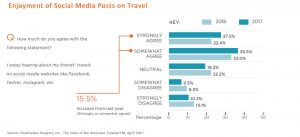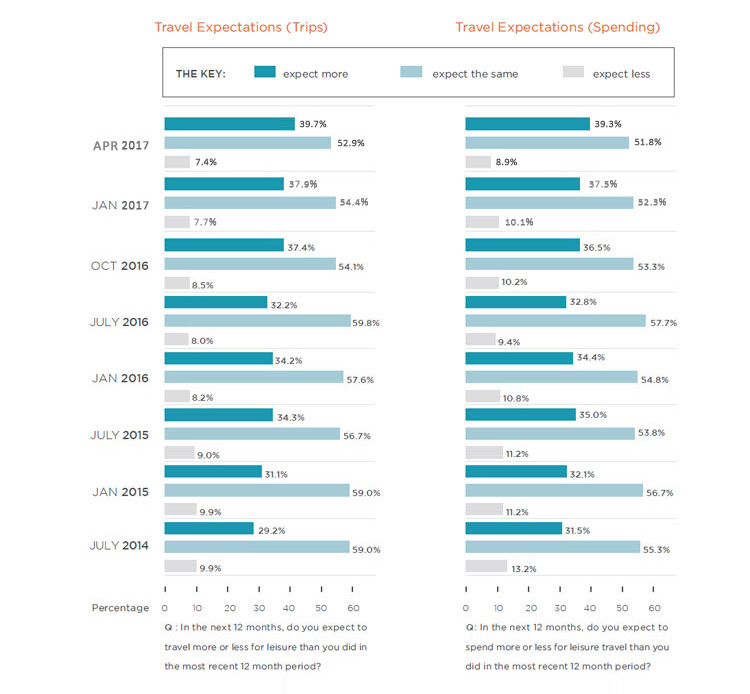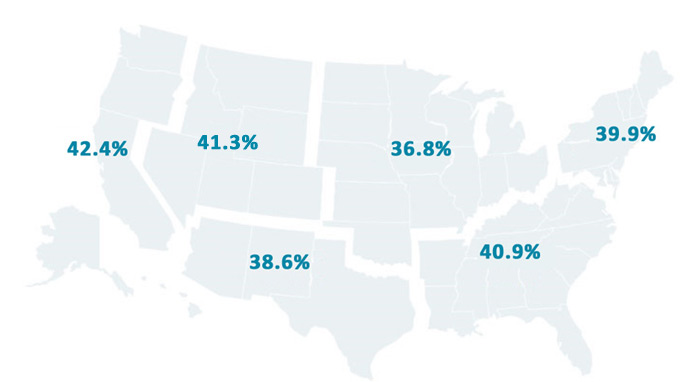Posts
In this most unusual of moments, there is a great deal of angst in the destination marketing world about the outlook for international visitation to the United States. Travel bans and outrageous rhetoric suggesting the possibility of “extreme vetting” for tourists from markets like Germany and France have analysts predicting that foreign demand for American travel product will fall sharply this year. While this situation is an extraordinarily serious problem, signs from domestic travelers point in the other direction. Our recently finished Spring edition of The State of the American Traveler™ shows that, at least on the home front, the outlook for leisure travel is surprisingly positive. In fact, Americans are planning more trips and more spending in the upcoming year than ever before, pointing to a strong performance in the remainder of 2017.
According to our April The State of the American Traveler™ tracking survey, more Americans than ever are expecting to increase the number of leisure trips they will take in the upcoming year. Leisure travel optimism is at a record high, mirroring positive trends seen in more general consumer confidence indices. This enthusiastic outlook is illustrated by a record 39.7 percent of Americans saying they expect to travel more for leisure in the next year, up from 37.9 percent in January. Leisure travel spending expectations are also high, with 39.3 percent of American travelers expecting to increase their leisure travel spending in 2017.
The chart below shows this strong optimism, illustrating the share of American leisure travelers who (in the next 12 months) expect to travel more, less and the same as they did in the most recent 12-month period.
(Percent of all leisure travelers)
Meanwhile, future travel sentiment across the country remains somewhat uneven, with residents of the West coast showing the highest levels of optimism for travel in the upcoming year. 42.4 percent of residents of the Pacific Coast region expect to travel more in the upcoming year, while 39.9 percent of travelers living in the Northeast and 40.9 percent in the Southeast expect to increase the number of trips they will take in the next year.
(Percent of leisure travelers)
Destination Analysts’ Takes on the Dallas Leisure Market
Destination Analysts’ founder recently presented one of our company’s most popular speaking topics to a group of hoteliers and DMO professionals at a joint luncheon hosted by the Hospitality Sales and Marketing Association International and the Dallas Fort Worth Area Tourism Council. Several hundred tourism leaders from the Dallas area were presented new data from Destination Analysts’ The State of the American TravelerTM and The State of the International TravelerTM studies, as well as video interviews of travelers discussing their perceptions of Dallas. A summary of key takeaways follows:
The DFW Metroplex is America’s fourth biggest city. Yet, like many destinations, it suffers from a significant awareness and understanding deficit both domestically and abroad. The situation is shown below, using findings taken from our most recent The State of the American TravelerTM survey–a nationally representative survey of 2,000 domestic leisure travelers. When asked in an unaided question to write in the five domestic destinations they most want to visit in the upcoming year, only 2.3 percent wrote in Dallas. The only other area cities receiving votes were Fort Worth (0.2%) and Arlington (0.1%). These disappointing results are, of course, not commensurate with a great city like Dallas.
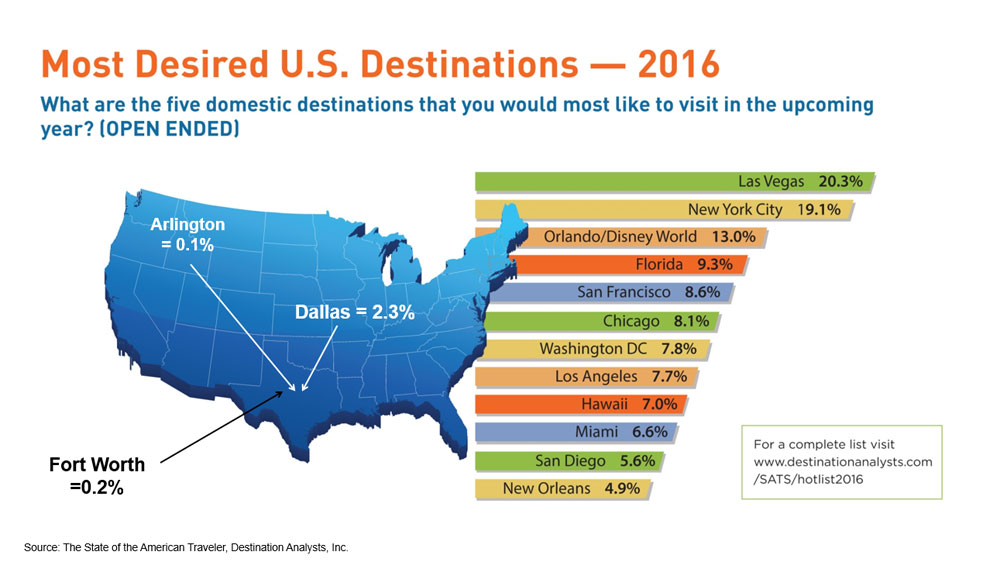
What’s beneath this situation? Despite the outstanding efforts of the metro area’s DMOs and the tourism community overall, the Metroplex obviously faces stiff competition from many compelling and well-funded destinations around the country. Obviously, too, the destination’s message hasn’t penetrated deeply into travelers’ awareness. The chart below shows (for numerous destinations) the relationship between destination appeal, perceived traveler familiarity, and likelihood of visitation. The chart shows visually that the more appealing a destination is, the more likely travelers are to say they are likely to visit it. Further, higher levels of familiarity foster both appeal and likelihood to visit. In this perspective, the Metroplex, while outpacing in-state rivals Austin and Houston, sits in the rear-middle of the pack nationally. This is no place for what is undeniably one of the nation’s most unique and vibrant communities. In our view, this dramatically highlights the need for local communities to continue to support (and very importantly fund) the marketing efforts of area destination marketing organizations.
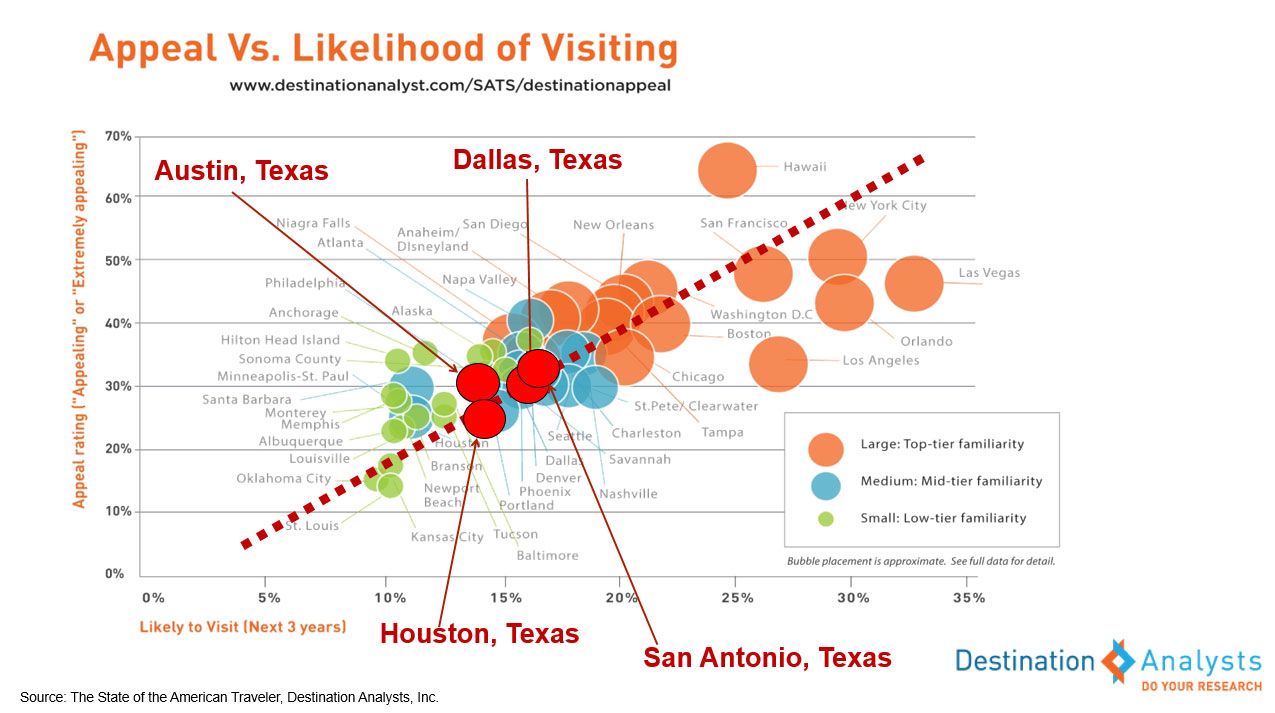
We won’t go into the detailed data in this blog post, but Dallas’ story is the same for international markets. Our The State of the International TravelerTM survey asked 800 likely international travelers in each of 14 major international feeder markets the same set of questions—measuring traveler familiarity, destination appeal and likelihood of visitation. These international results mirror the domestic ones, with Dallas getting relatively low rankings for all three metrics when compared to an array of other U.S. destinations.
The Silver Lining
The DFW Metroplex is a world-class destination, with fantastic attractions, attributes and significant potential. When you’re familiar with the place, it’s hard not to be optimistic about the possibilities. Despite the destination’s challenged current position, our research shows that the area is seen as attractive by a very valuable audience–sophisticated, younger travelers willing to spend money of leisure travel. A segmentation analysis shows that when we compare travelers who say they find Dallas to be an “Appealing” leisure destination to other travelers (i.e., those who do not find the city to be an appealing leisure travel destination) an interesting profile emerges:
American Leisure Travelers who Find Dallas Appealing are:
(Compared to those who don’t find Dallas Appealing)
Demographically different. They are:
More ethnically diverse (69.9% vs. 80.6% Caucasian)
More likely to be Millennials (37% vs. 21.0%)
Frequent Travelers. They:
Took more leisure trips taken in past 12 months (4.8 vs. 4.2 trips)
Are more likely to be international travelers (37% vs. 21% have traveled overseas in the past 12 months)
Have higher travel optimism (44% vs. 31% expect to travel more this year than last)
Are 68% more likely to expect to visit a metropolitan destination this year for leisure reasons
Consume Far More Travel Content When Travel Planning
(% that used each resource to plan a leisure trip in past 12 months)
User-generated content (69% vs. 55%)
Social media (68% vs. 42%)
Online Travel Agencies (40% vs. 27%)
Information gathered from a mobile phone (69% vs. 42%)
A DMO website (50% % vs. 30%)
Bigger Travel Spenders. They have:
Similar incomes, yet…
“Personal financial reasons” constrained their travels less this year (36% vs. 40%)
Expect to spend more this year on leisure travel (44% vs. 31%)
Have 30% larger annual travel budgets ($4,100 on average)
The State of the American TravelerTM – April Update
————————————
Oops! If you’ve arrived here via our email, please forgive the glitch in our copy. If you’re interested in romance and the American traveler, click here. If not, please just read on to see how American travel optimism is at an all-time high!
————————————-
If you’ve been paying attention, you’ll know that the U.S. economy has been throwing off some seriously mixed signals during the early part of this year. The bull market turns into a bear, then reverses itself. First quarter GDP growth weakens, but now seems likely to be revised upward; with many economists now seeing the second half of the year as one of strong growth. Long troublesome exchange rates flip, possibly even hitting an inflection point where the dollar may become a boost to exports. Meanwhile, recent data shows the domestic service sector expanded in April as new orders and employment both jumped.
Whatever happens during the rest of the year, we know that ours is a consumer driven economy. Consumers account for more than 70 percent of spending, and in the moment are surprisingly bullish about their future leisure travel. Our April The State of the American TravelerTM survey shows travelers cheerful mood is clearly ongoing. Our survey tracks traveler intent to travel and spend in the upcoming year. Both measures reached historic levels this month. The chart below show this enthusiasm, as more travelers are planning to take a greater number of trips in the upcoming year.
Travel Optimism Grows to Record Levels
(% of American Leisure Travelers Expecting to Take More Trips in the next 12 Months)
Not only are American travelers planning to travel more, they’re ready to spend. As the chart below shows, spending expectations are also sky high. More than one third (35.5%) of travelers expect to spend more in the upcoming year than they did in the last one–yet another record.
Travel Spending Expectations Up
(% of American Leisure Travelers Expecting to Spend More on Leisure Travel in the next 12 Months)

As we move into the peak of summer travel season, this optimism bodes very well for the travel industry. Mixed economic signals or not, American travelers seem primed for an excellent season of exploring our many great destinations.


